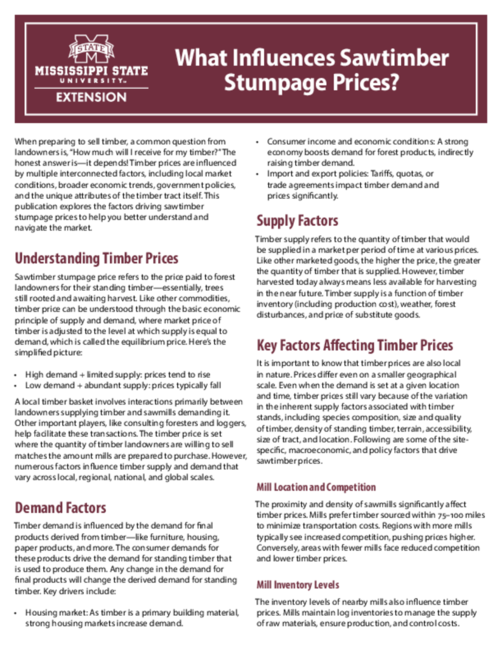P4127
What Influences Sawtimber Stumpage Prices?
When preparing to sell timber, a common question from landowners is, “How much will I receive for my timber?” The honest answer is—it depends! Timber prices are influenced by multiple interconnected factors, including local market conditions, broader economic trends, government policies, and the unique attributes of the timber tract itself. This publication explores the factors driving sawtimber stumpage prices to help you better understand and navigate the market.
Understanding Timber Prices
Sawtimber stumpage price refers to the price paid to forest landowners for their standing timber—essentially, trees still rooted and awaiting harvest. Like other commodities, timber price can be understood through the basic economic principle of supply and demand, where market price of timber is adjusted to the level at which supply is equal to demand, which is called the equilibrium price. Here’s the simplified picture:
- High demand + limited supply: prices tend to rise
- Low demand + abundant supply: prices typically fall
A local timber basket involves interactions primarily between landowners supplying timber and sawmills demanding it. Other important players, like consulting foresters and loggers, help facilitate these transactions. The timber price is set where the quantity of timber landowners are willing to sell matches the amount mills are prepared to purchase. However, numerous factors influence timber supply and demand that vary across local, regional, national, and global scales.
Demand Factors
Timber demand is influenced by the demand for final products derived from timber—like furniture, housing, paper products, and more. The consumer demands for these products drive the demand for standing timber that is used to produce them. Any change in the demand for final products will change the derived demand for standing timber. Key drivers include:
- Housing market: As timber is a primary building material, strong housing markets increase demand.
- Consumer income and economic conditions: A strong economy boosts demand for forest products, indirectly raising timber demand.
- Import and export policies: Tariffs, quotas, or trade agreements impact timber demand and prices significantly.
Supply Factors
Timber supply refers to the quantity of timber that would be supplied in a market per period of time at various prices. Like other marketed goods, the higher the price, the greater the quantity of timber that is supplied. However, timber harvested today always means less available for harvesting in the near future. Timber supply is a function of timber inventory (including production cost), weather, forest disturbances, and price of substitute goods.
Key Factors Affecting Timber Prices
It is important to know that timber prices are also local in nature. Prices differ even on a smaller geographical scale. Even when the demand is set at a given location and time, timber prices still vary because of the variation in the inherent supply factors associated with timber stands, including species composition, size and quality of timber, density of standing timber, terrain, accessibility, size of tract, and location. Following are some of the site-specific, macroeconomic, and policy factors that drive sawtimber prices.
Mill Location and Competition
The proximity and density of sawmills significantly affect timber prices. Mills prefer timber sourced within 75–100 miles to minimize transportation costs. Regions with more mills typically see increased competition, pushing prices higher. Conversely, areas with fewer mills face reduced competition and lower timber prices.
Mill Inventory Levels
The inventory levels of nearby mills also influence timber prices. Mills maintain log inventories to manage the supply of raw materials, ensure production, and control costs. When the inventory levels are full, mills may reduce or stop purchasing wood, resulting in lower timber demand. This situation often drives prices down. When the inventories decline, mills are forced to increase procurement even at higher prices to fill the gaps.
Weather Conditions and Forest Disturbances
In the southern U.S., weather substantially affects timber supply:
- Wet weather: Limits logging operations and reduces supply, increasing prices.
- Dry weather: Facilitates logging and increases supply, potentially lowering prices.
- Extreme events (e.g., hurricanes): Initially floods markets with salvage timber, which lowers prices, and then reduces long-term supply, which increases prices.
In addition, wildfires and insect pest infestations also affect timber supply at the local market for both the short and long term.
Tract Characteristics
Timber tract qualities significantly affect stumpage prices.
- Size and accessibility: Larger, accessible tracts close to roads and mills attract higher prices.
- Timber quality: High-quality timber preferred by manufacturers has greater size and density, is straight with minimal taper, and is free of knots and excessive branching, among other characteristics. Preferred species include loblolly pine, cherrybark oak, and white oak.
Housing Starts
U.S. housing starts strongly correlate with timber prices. As lumber is essential for home construction, increased housing starts directly boost timber demand and prices. It is advisable to keep track of housing market trends to predict timber market movement.
Government Regulations and Policies
Policies like logging restrictions, import tariffs, forest conservation, and sustainability regulations impact timber costs and prices. Landowners should stay informed about policy changes affecting forestry practices and market opportunities.
Technological Advances
Innovations in logging equipment, forest management, and wood processing can reduce costs, potentially affecting timber prices positively for landowners.
Summary
Sawtimber prices are driven by a blend of local, regional, and global factors. Understanding these drivers can help forest landowners, investors, consultants, and loggers strategically navigate the market, optimize returns, and achieve sustainable management objectives.
Publication 4127 (POD-08-25)
By Sushma Bhattarai, PhD, Extension Associate I, and Sabhyata Lamichhane, PhD, Assistant Professor, Forestry.
The Mississippi State University Extension Service is working to ensure all web content is accessible to all users. If you need assistance accessing any of our content, please email the webteam or call 662-325-2262.
